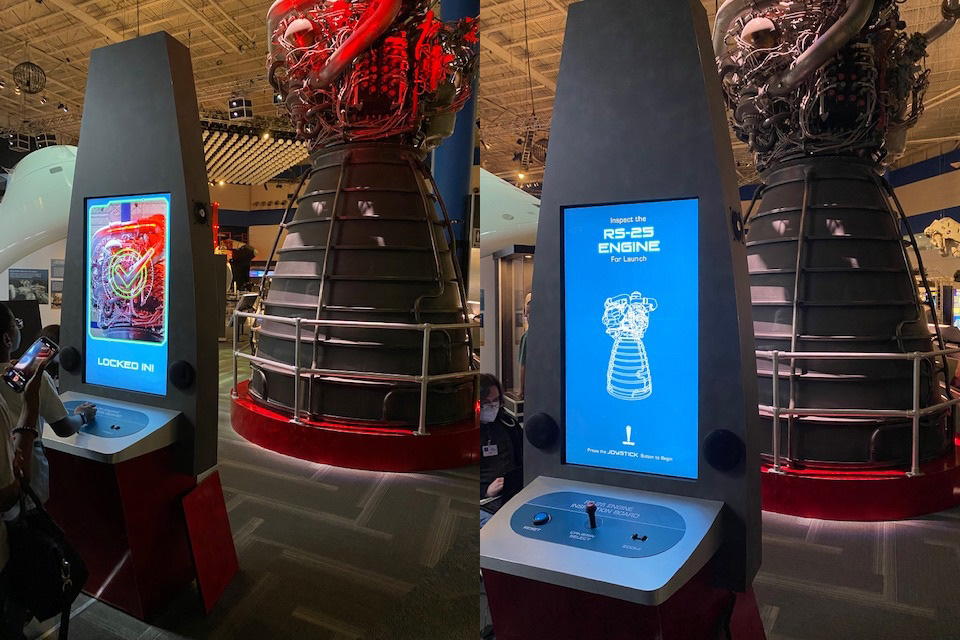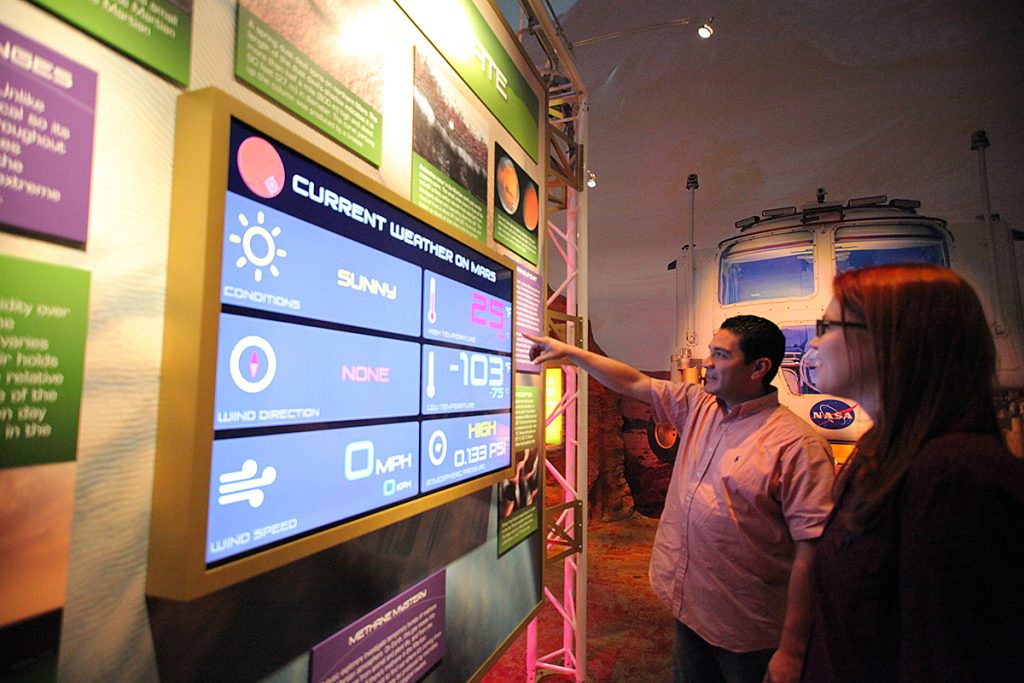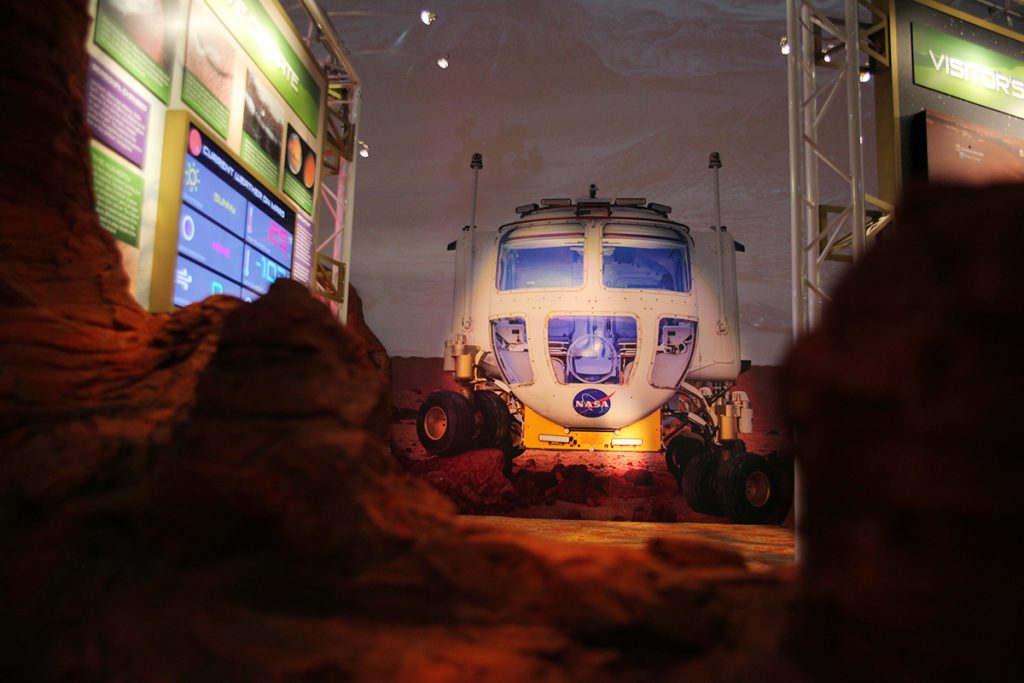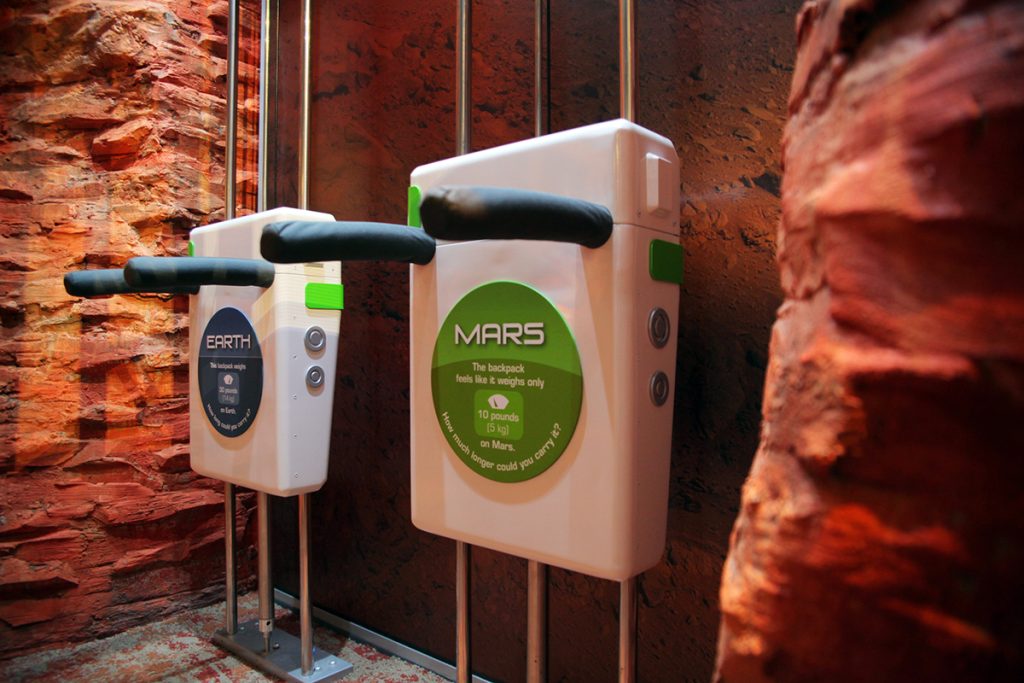Home » Exhibits and Experiences » Mission Mars
Discover what it takes to travel to Mars, what hardware will get us to the fourth planet in our solar system and how humans may live on the red planet in the next few decades.
Space Center Houston worked closely with NASA in the development of the Mission Mars exhibit, which guides visitors through NASA’s journey to Mars, beginning with a look at how our view of the red planet has changed through the ages.
Touch a real piece of Mars and see a collection of other rare meteorites. There are fewer than 150 Mars meteorites, and most of those are held in private collections. Don’t miss your chance to see and touch an actual piece of the red planet in Mission Mars.
NASA’s Space Launch System (SLS), the most advanced and powerful rocket under design, will launch future explorers on their journey to Mars. Inside the Mission Mars exhibit, stand beside a towering, 45-foot 1/8th scale model of the SLS and inspect the Space Launch System main engine, RS-25 (previously used by shuttle orbiters), the most efficient engine ever built, with our new rocket engine “inspection station.”




The rocks and soil of the red planet tell their own story. In a stunning 4K wall projection that reaches a height of five stories, experience what it’s like to stand on the surface of Mars. See red, rolling Martian hills in a virtual landscape with rovers exploring the planet, a future rocket launching from Earth and heading for Mars and future astronauts landing.
Find out how the geology of Mars differs from Earth — from massive canyons more than twice as deep as the Grand Canyon to staggering mountains three times as tall at Mount Everest.
Find out how future spacesuits differ from current and past suits, and see how new suits will look and function.
Get a look at the next generation of rovers called Surface Exploration Vehicles (SEVs). Find out how far you can go in an SEV, how many astronauts fit inside and other details of the ultimate off-worlding vehicle.
Did you know Mars has storms, including dust storms that can take months to subside and for all the particles to settle? Discover how Mars’ orbit and thin atmosphere affect its weather and seasons.
Feel the difference gravity makes in a hands-on activity demonstrating how Mars gravity differs from gravity on Earth.
NASA’s Space Launch System (SLS), the most advanced and powerful rocket under design, will launch future explorers on their journey to Mars. Inside the Mission Mars exhibit, stand beside a towering, 45-foot 1/8th scale model of the SLS and see the space launch system main engine, RS-25, the most efficient engine ever built.
Peer inside a full-size Orion research model used by engineers from NASA Johnson Space Center and Lockheed Martin to study ergonomics and astronaut emergency escape procedures. Afterward, try your hand at being a space explorer in our one-of-a-kind Orion capsule simulator. Climb into the simulator to see, touch and hear what it will be like for the first astronauts who travel to Mars.

One of the most inhospitable aspects of life on Mars is radiation. There is a massive amount of radiation in space, mainly originating outside the solar system. Astronauts will have to shield themselves from this radiation during the journey. They also need radiation-blocking habitats while living on Mars because the much thinner Martian atmosphere does not shield as much radiation as Earth’s atmosphere. Test a selection of materials to discover how they protect astronauts from this cosmic radiation.
What would you pack on a journey to Mars? The weight of every item in the spacecraft must be accounted for to get the most out of the rocket’s thrust. As a result, astronauts are only allowed to take the minimum amount of equipment and resources required to complete their mission as well as a very limited number of personal items for emotional health. Pack a rocket to Mars and see if it completes the mission.
When supplies are limited by weight, food must be rationed as well. Consequently, astronauts will need to grow food in space. Learn about NASA’s plant growth system called “Veggie” that will allow astronauts to grow food in space and on Mars. See what space crops may look like on Mars.
In addition to input from subject-matter NASA experts, NASA’s Office of Education provided a grant through the Competitive Program for Museums, Science Centers, Planetariums and NASA Visitor Centers. These grants are designed to create interactive exhibits to engage the public, students and teachers in NASA-themed science, technology, engineering and math education. Lockheed Martin provided the high fidelity Orion capsule trainer, along with financial support for the exhibit construction.
Make it your mission to learn all about this fascinating world in our newest exhibit, Mission Mars. Get your tickets today!
HOURS TODAY
The All-American Rejects are throwing Space Center Houston’s Moon 2 Mars Festival into hyperdrive. Amp up your Space City Spring Break with us!
Access to this all-ages festival is included in general admission.
WEATHER ALERT
For the safety of our guests and staff, Space Center Houston is closed on Tuesday, January 21 and Wednesday, January 22 due to forecasted inclement weather.
We apologize for the inconvenience and look forward to welcoming you soon! For questions or concerns, contact our Reservations team with your order number at 281.283.4755 or via email.